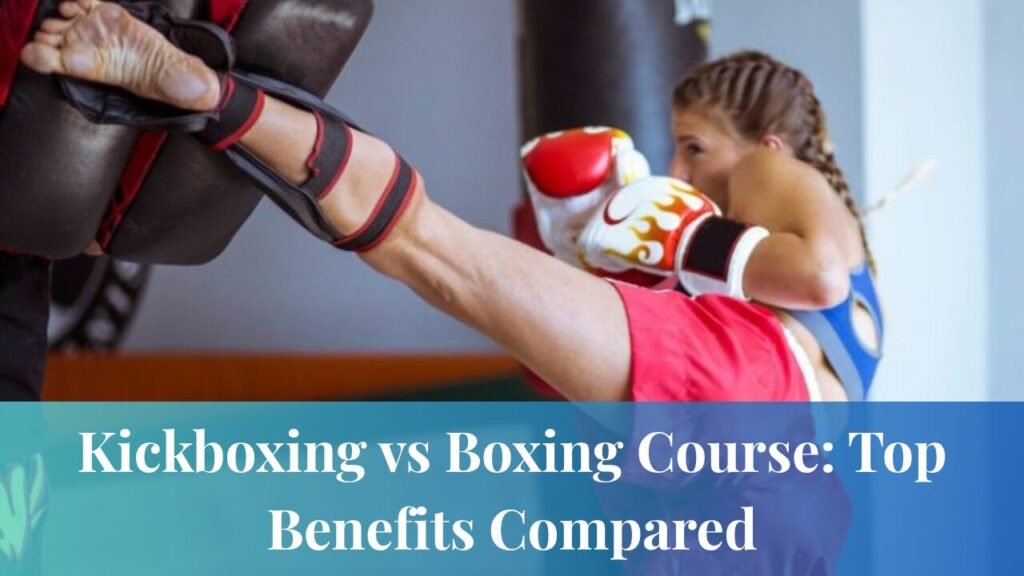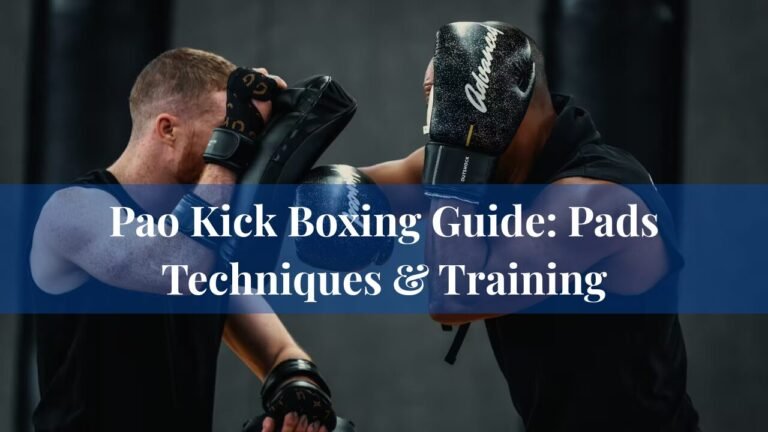Kickboxing and boxing are two of the most popular combat sports and fitness disciplines worldwide. While they may seem similar on the surface, the benefits offered by each course are distinct and can vary based on your personal goals, fitness level, and interests. Whether you’re aiming to boost cardiovascular endurance, learn self-defense, or build strength and confidence, understanding the kickboxing vs boxing course benefits is essential for choosing the right path.
This article explores all aspects of both sports, including their physical and mental benefits, training differences, and how to decide which course best aligns with your personal goals.
Understanding Kickboxing and Boxing
Boxing is a striking combat sport that revolves exclusively around punching techniques. Athletes wear gloves and focus on delivering strategic punches while employing defensive maneuvers such as blocking, dodging, and footwork. With a rich history in competitive and recreational sports, boxing is deeply rooted in tradition and discipline.
On the other hand, kickboxing blends boxing techniques with martial arts-style kicks. Depending on the style—such as Muay Thai, American Kickboxing, or K-1—it can also include knees, elbows, and clinching. Kickboxing evolved from karate and boxing and offers a modern hybrid approach to combat and fitness.
Key Differences Between Kickboxing and Boxing
While both sports share a focus on striking, their techniques and training styles differ. Boxing emphasizes upper-body strength, linear movement, and precision through hand strikes and defensive movements. In contrast, kickboxing incorporates full-body movement, pivoting, and balance shifts through the use of both hands and legs. This makes kickboxing a more dynamic and calorie-intensive workout, with additional complexity in its technique.
Defensive tactics also differ significantly. Boxing relies on head movement and blocking with the arms, while kickboxing requires checking and catching kicks, making it a more comprehensive approach to physical engagement. Each sport has its own rhythm and set of skills that cater to different fitness goals.
Cardiovascular Fitness
Both boxing and kickboxing offer powerful cardiovascular workouts that enhance heart health, stamina, and lung capacity. Kickboxing often has a slight edge due to the full-body nature of its movements, requiring constant activity and engaging more muscle groups. The inclusion of kicks, jumps, and transitions challenges the cardiovascular system on a broader scale.
For those aiming to improve endurance and maintain heart health, either sport is a strong option. However, the additional movement patterns in kickboxing might make it more effective for those seeking to push their aerobic limits.
Strength and Conditioning
Boxing primarily develops upper-body strength through repeated punching drills, while also engaging the core and legs during footwork. The shoulders, arms, chest, and back are the main areas targeted in boxing routines. Foot movement builds agility and lower-body endurance but is generally less demanding on the legs compared to kickboxing.
Kickboxing provides a more holistic strength workout by involving the legs through high kicks and knee strikes. These movements activate the glutes, quads, hamstrings, and calves, delivering a balanced full-body routine that enhances muscular strength from head to toe.
Fat Loss and Muscle Toning
When it comes to burning calories and losing fat, kickboxing tends to have the upper hand. Its full-body demands and higher-intensity movements result in more calories burned per session, especially during extended combinations and fast-paced drills. This makes it highly effective for fat loss when combined with proper nutrition.
Both sports contribute significantly to muscle toning, but kickboxing’s diversity of motion creates more opportunities for full-body sculpting. Over time, consistent practice can lead to improved muscle definition, reduced body fat, and better body composition.
Coordination and Balance
Boxing is excellent for improving hand-eye coordination, timing, and rhythm. It demands sharp reflexes and controlled footwork, which develop fine motor skills and spatial awareness. The ability to punch while maintaining defense enhances overall athleticism.
Kickboxing builds on this foundation by adding leg strikes, which require even greater balance and body awareness. Executing high kicks while staying grounded challenges the nervous system and improves neuromuscular coordination. This makes kickboxing particularly effective for enhancing balance and complex movement patterns.
Core Development
Both sports engage the core extensively, though in slightly different ways. Boxing strengthens the abdominals and obliques through the rotational force generated in punches. Core stability is essential for maintaining balance and delivering power from the ground up.
Kickboxing amplifies core development through kicks, knee strikes, and transitions that force the midsection to work harder to stabilize the body. As a result, participants often experience quicker core strengthening and more visible midsection results with regular practice.
Stress Relief
The stress-relieving benefits of both boxing and kickboxing are well documented. The act of striking pads or bags provides an emotional release, reducing tension and promoting relaxation. These workouts increase endorphin levels, which help improve mood and reduce anxiety.
Engaging in either discipline after a stressful day can offer both a mental break and a physical outlet. The repetitive, focused nature of the training encourages mindfulness and leaves practitioners feeling more centered and energized.
Mental Focus and Discipline
Both sports require mental sharpness, coordination, and discipline. Memorizing combinations, reacting to instructors or sparring partners, and staying alert during drills keep the brain highly engaged. This improves cognitive function and focus over time.
Boxing, in particular, demands intense concentration due to its technical precision and timing. Kickboxing requires rapid transitions between techniques and body positions, developing mental agility and adaptability. Both foster strong mental habits that carry into other areas of life.
Confidence and Self-Esteem
Gaining proficiency in either sport naturally builds confidence. Learning to move your body powerfully and defend yourself contributes to a sense of self-assurance. As skills improve and physical goals are met, self-esteem increases.
Group classes often promote camaraderie and support, helping individuals feel more empowered and motivated. Whether it’s mastering a new combination or completing a tough session, small wins along the way boost personal growth and confidence.
Emotional Resilience
Combat sports build emotional resilience by teaching practitioners how to stay calm under pressure and recover from setbacks. In both boxing and kickboxing, there are moments of fatigue, challenge, and failure. Facing and overcoming these teaches perseverance.
The ability to remain composed during high-intensity training builds a mindset that can handle real-life stressors with more ease. Practitioners learn to embrace discomfort, push through adversity, and develop a strong, adaptable mindset.
Self-Defense Capabilities
Boxing courses focus on delivering accurate punches and using footwork to avoid and counter attacks. Techniques such as jabbing, slipping, and blocking translate well into real-life self-defense scenarios where hand speed and positioning are key.
Kickboxing adds a broader range of techniques, offering long-range strikes like kicks and knees. These additional tools give students more defensive and offensive options in a confrontation. The inclusion of lower-body strikes makes kickboxing a more well-rounded self-defense system.
Choosing the Right Course Based on Your Goals
If your primary goal is fitness and fat loss, kickboxing is generally the better option due to its full-body movements and higher calorie burn. It keeps the entire body engaged and provides a faster track to overall conditioning.
For those prioritizing self-defense, kickboxing again comes out ahead thanks to its diverse arsenal of strikes. If mental discipline is your focus, boxing’s emphasis on timing and control helps sharpen focus and reflexes. Ultimately, your personal preferences and interests should guide your choice.
Real-World Testimonials and Case Studies
Michelle, a 32-year-old from New York, took both classes at HotFit NYC and found kickboxing to be more enjoyable and effective for weight loss. She lost 15 pounds in three months and described the experience as a fun blend of dance and combat.
Jordan, 27, from Toronto, took boxing courses at Art of Kickboxing and found they greatly enhanced his ability to move, react, and strike correctly. He noted feeling sharper and more focused in his daily life. Meanwhile, Kevin, 41, from Vancouver, joined a hybrid kickboxing program and experienced dramatic health improvements, including 20 pounds lost and reduced blood pressure.
How to Choose a Quality Course
A good training program should be led by certified trainers with experience in either fitness or combat sports. Look for facilities that maintain clean, safe environments and offer a supportive community for all levels. Positive reviews, structured curriculums, and accessible equipment also indicate a well-run course.
One example is Stamina11 Kickboxing, which holds a 4.9-star rating from over 250 Google Reviews. They provide clearly structured courses for beginners and advanced practitioners, with options to try classes before committing.
FAQs
What burns more calories boxing or kickboxing?
Kickboxing typically burns more calories due to full-body movement, especially involving the legs and core. It also increases post-exercise oxygen consumption, leading to continued calorie burn.
Is kickboxing harder than boxing?
It depends on your fitness level. Kickboxing requires more coordination and flexibility, while boxing emphasizes timing and precision. Both are intense in their own ways and demand discipline.
Can beginners join either class?
Absolutely. Most gyms offer beginner-friendly courses with modifications for all levels. Look for intro programs or speak to trainers before joining.
Which is better for women?
Both are excellent. Kickboxing may appeal more due to its dynamic movements, while boxing offers powerful upper-body empowerment. Many women find kickboxing empowering because of the variety of strikes and cardio benefits.
Do I need gear for the first class?
Most gyms provide basic gear for first-timers. Over time, you may want to invest in personal gloves, wraps, mouthguards, and shin guards (for kickboxing). Wearing appropriate athletic clothing and maintaining hygiene is also important.
What is the cost difference between the two?
Pricing can vary by gym, but both courses are usually similarly priced. Kickboxing may require more gear upfront. Many gyms offer packages or monthly memberships, which can make training more affordable.




